Mon 16 Jun 2014
A Western Movie Review by David Vineyard: KEOMA aka DJANGO RIDES AGAIN.
Posted by Steve under Reviews , Western movies[11] Comments
KEOMA. 1976. Also released as Django Rides Again and The Violent Breed. Franco Nero, Woody Strode, Olga Karlatos, Donald O’Brien, William Berger, Gabriella Giacobbe. Directed by Enzo G. Castallari.
An arty and allegorical Spaghetti Western with half a brain and good direction and cinematography, Keoma turns out to ultimately be more entertaining than annoying, and better acted than it has any right to be with an existentialist message at the end right out of Sartre.
Keoma: “He won’t die, he’s free. And a free man can never die.â€
Okay, if he says so, but for all that, this proves to be a really good western of its type, with first class performances by Franco Nero and Woody Strode, and one stunningly beautiful pregnant woman (Olga Karlatos) named Lisa who bears the burden of most of the allegory about life, death, birth, existence, sacrifice, suffering, freedom, and hope (well, she is very pregnant).
Admittedly that’s a lot for a western– even an Italian-made western shot in Spain — to bear, but this one manages better than most. It makes for some pretentious fun. It’s no where near as good as High Plains Drifter, but it’s nowhere near as bad as Pale Rider, as pretentious westerns go.
Nero is the gray eyed long-haired (how those braids survive holding the mess back got a bit distracting I have to grant) half-breed Keoma, who returns home after the Civil War.
“Which side were you on?â€
“It just happened I was on the winning side.â€
There he finds a spooky old Indian witch (Gabriella Giacobbe) who wanders in and out of the film like a silent Greek chorus as Keoma’s conscience and a sort of early warning signal of impending trouble. She warns him he should not have returned, but like any western hero in any western ever made anywhere, common sense isn’t his long suit, so he rides right into a group of ex-Confederate cackling coyote-mean escapees from Deliverance (are there any other kind?), taking prisoners with the plague to the mines to isolation and death.
Among them is one pregnant woman, Lisa, the stunningly beautiful Karlatos, with eyes every bit as spooky as the wolf eyed Nero. Pregnant, with straggly hair, and in extremely unflattering clothes, she is still one of the most beautiful women you will ever see in any film.
Typically he makes enemies fast, kills one of the ex-Rebs, and takes the woman to town, where no one wants her, and he promptly has to kill again and further annoy an ex-Confederate rancher and power mad criminal named Caldwell (Donald O’Brien, the film’s weakest link) who caused the plague with poisoned wells, and now holds the town hostage refusing to allow anyone to bring in medicine or help. No one ever explains just how this helps him since he has already grabbed all the land. I guess he’s just mean.
In addition Keoma finds his childhood friend and mentor George (Woody Strode) a broken old drunk waiting to die in the streets.
Keoma: “But you’re free now.â€
George: “I found out what freedom means.â€
Like heavy, man (well, it was the seventies).
Keoma it turns out was a half-breed child rescued by a fast gun, William Shannon (William Berger), with three sons of his own. Of course they are no damn good — they tortured and beat Keoma — and as ex-Confederates themselves, they ride with Caldwell and their once proud and deadly father is old, afraid to die, and fears having to kill his own sons. But he’s glad to have Keoma back.
Shannon: “We stopped slaughtering and butchering the Indians long enough to free the black man and now we are back to finish with the Indians.â€
That comes a bit out of left field, since other than the knowledge that Keoma’s village was slaughtered by white men and Keoma the only survivor, and all the bad guys, brothers included, go on about him being half-Indian, Indians have almost nothing to do with the plot except as shorthand for oppressed and exploited people, and that old Indian woman (great face) who keeps wandering in and out at key points often back lit by lightning and sunlight.
This is a beautifully shot film. Visually it is great to look at and the print I saw was off an original 35mm letterboxed master in one of those collections of twelve films, this one including One Eyed Jacks, another pretentious western, but not as good as this one despite the cast and stunning cinematography.
Keoma is about as much Tarzan or Conan here as a western hero, a sort of force of nature, the ultimate existentialist hero who worships only one thing, freedom at any price — no matter who he gets killed in winning it for them.
It’s a very physical role for Nero, mindful of the kind of action film Burt Lancaster and Kirk Douglas often made full of running, leaping, fighting, and defying gravity, and in the stunts that are obviously Nero, he looks and performs the physical side more than adequately. Of course he was an old hand at this and even makes a sly cameo in Quentin Tarantino’s paean to the form, Django Unleashed (for anyone who didn’t get the joke Nero — among others — this was also released as Django Rides).
You have to give the director and multiple screenwriters credit too, because this could easily have devolved into maudlin flashbacks of Keoma’s troubled childhood, but instead they chose a form of virtual Latin American Magic Realism where the characters in the here and now are physically in the flashback scenes with their younger selves. Once you get past the initial shock it is very effective and in some ways presages the famous ending of Robert Benton’s Places in the Heart.
You can guess how the plot works out: there’s the good doctor who regains his nerve; George regains his manhood; Shannon stands by his good adopted son, Keoma; Shannon and George take on the entire Caldwell army in a well shot orgy of gunfighting and violence; and Keoma ends up crucified in the rain on a wagon wheel in the middle of town only to be rescued by Lisa, the dying pregnant woman.
The final shootout in an old abandoned fort where the film opened, with Keoma battling his three adopted brothers is well staged with the screams of the woman in labor and the cries of her newborn muffling the gun fire (I warned you it was arty) and the old witch looking on.
But don’t shoot me, it isn’t my fault that Keoma, having done everything but backflips to see the child is born, then deserts him with the old Indian woman with than nonsense about a free man can’t die. See how much milk and how many diapers existentialist philosophy will buy you; carrying existentialism a shade too far as far as I’m concerned.
The major problem for me was the damn musical soundtrack, really lame senseless ballads I could barely understand that sounded like the mewling of the cattle from Red River done to music or the male part like a coyote with a sore throat trying to spit phlegm up (and that is being kind — “Do not forsake me oh my darlin'” it’s not), the woman singing alone had a vibrato on high notes that must be how Madame Castafiore sounds to Captain Haddock in Tintin. You will be amazed how many vowels she manages to squeeze into the name Keoma. She sounds like the love child of Joan Baez and Slim Whitman.
That said, the dubbing was first class with Nero and Strode at least doing their own voices.
But messy as it is at times, I more than recommend this one. It mostly succeeds at what it is obviously trying to do, there is some strong and effective imagery, plus stunts, good use of lighting and staging, and more often than not, it rises to what it seems to want to be. Granted the main villain is a bit lame, but he’s only an afterthought to the conflict between the brothers and Keoma.
And if any of you have seen it and remember, maybe you can clear up whether Keoma was just rescued by Shannon, or Shannon’s son by his Indian mother. At one point that seems to be the implication, and then later I wasn’t so sure. I guess that happens when a small army writes the screenplay. They never clear up if the people at the mine dying of plague are saved either. Guess it wasn’t worth the bother.
I enjoyed this one much more than I expected. If there is another half this good on the set then I won’t feel I wasted $5. This is one of the better thought of and appreciated later Spaghetti westerns, and it isn’t hard to see why.
Still, I can’t help but wonder if Tonto — Keoma — would have fared better here with the help of the Lone Ranger.
Just asking.
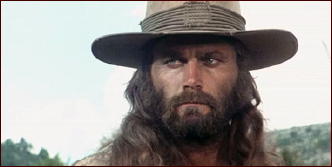
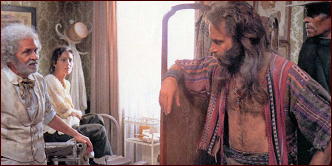
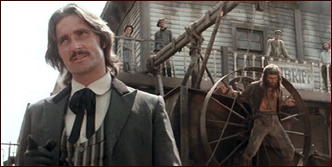

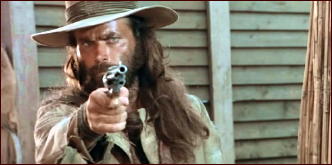
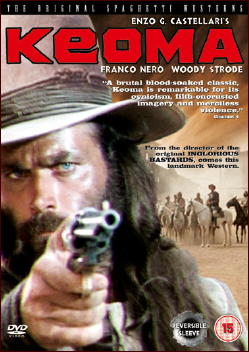
June 16th, 2014 at 10:30 pm
All very interesting. I own Keoma on a 12-pack DVD collection, perhaps the same one you have. I bought it for $4.99. Have not watched it yet, now I shall.
I get the sense that Quentin Tarantino has seen an incredible number of not only the Italian, but also the Spanish, spaghetti westerns. I haven’t seen the Django Unchained yet, but I feel like I probably should.
Always appreciated Franco Nero. A great non-Western role of his was in “Force 10 From Navarone” (1978) directed by Guy Hamilton. One of my favorite war movies. Also with a great appearance by Richard Kiel as a Serbian collaborator.
June 17th, 2014 at 12:20 am
Nero made some good action and crime movies in Italy as well, and of course Camelot. There is one with Bekim Fekhu set on an oil rig that I recall, at least I think Fekhu was in it. I’ll have to IMDb to be sure.
I love the Spaghetti Western he did with Jack Palance and Tony Musante, the latter as a Mexican revolutionary bandit from the gang who couldn’t shoot straight..
Tarantino used the theme song from the Richard Harrison Spaghetti Western His Name Is King as the theme for the character King in Django Unchained, so you know he saw a ton of these. You will love the scene in Django Unchained when Kennedy starts to spell Django to Nero and gets a haughty “I know how its spelled.” I bet two thirds of the audience didn’t even get that.
Yeah, that’s the one I have and it s a hell of a good copy, much better quality than you might expect. His Name is King is on that one too. There are at least two other pretty good oaters in really nice prints on there too, though more common on these sets than Keoma.
You can also find the Terence Hill Lucky Luke (based on the comic book) on line as well as the really outlandish new one with Jean Dejardin. Both are well worth catching.
I saw many of these in France in the 70’s as well as many of the late sixties giallo and Eurospy stuff on television.
So you are the other guy who likes Force 10 From Navarone? I knew I wasn’t the only one.
June 17th, 2014 at 12:52 am
Some of those 1970s Italian (and French) crime films were really gritty with urban decay, highways, and run down parts of big cities.
When I was a kid, I had two favorite movies: Empire Strikes Back and Force 10 From Navarone. Lescovar (Nero) remains one of my favorite espionage/thriller villains. The scene on the train when Harrison Ford and Robert Shaw confront him and finally do away with him remains an all time favorite WW2 film moment for me. When I first watched it, I didn’t appreciate how much of an all star cast the film had. I own it on DVD. I also have a reissued edition of the novel, but haven’t read it yet.
June 17th, 2014 at 3:45 am
In the 70s, the Spaghetti Western went into a baroque period, with the films growing self-referential, gimmicky and a bit pretentious at times. Besides KEOMA, there were political allegories like COMPANEROS and two (count’em!) two Spaghetti Westerns based on HAMLET.
June 17th, 2014 at 3:47 pm
Dan
Keoma was in some ways the prototype for the major changes in the Spaghetti Western come the late seventies, and unlike many of the others it works for the most part.
Jonathan
There are some excellent gritty crime dramas that came out of Italy and France in that period, many much more violent and darker than some of their American counterparts. It’s a genre that never caught on here as much as the westerns, giallo, and Eurospy films, but well worth looking into. The caper films are a little better known, but still underappreciated.
The French, in particular made several fine crime dramas in the fifties and sixties, and not just Rififi and Bob le Flambeur. Films like the adaptation of Boris Vian’s I Spit on Your Grave (not the American exploitation film) with Christian Marquand or Francois Letterier’s Un Roi Sans Divertisement based on Jean Giono’s novel are too little known here. Jean Gabin did a fine turn as Simenon’s Maigret, and Costa Gravas 10:30 From Marseilles (The Sleeping Car Murders) are standouts. Of course there was Rider on the Rain based on an original idea by Sebastian Japrisot and starring Charles Bronson, as well as Goodbye Friend, another Japrisot outing with Bronson and Alain Delon rivals trying to hold up the same place on a Bastille Day weekend (a number of French films are loosely or directly based on the famous July 14-16 Bastille Day commando style bank robbery in Marseilles).
Some later films like Borsalino, Truffaut’s Mississippi Mermaid, Shoot the Piano Player, The Sicilian Clan (Rififi in New York)and the Franco-American Once a Thief, and Le Circle Rouge aren’t that hard to find either, but the rarer ones do make you want to invest in a Region 2 DVD player.
June 17th, 2014 at 5:22 pm
Great movie, but terrible theme song.
June 17th, 2014 at 6:16 pm
David,
All good suggestions.
I studied French for many years and learned to read it fairly well. Never got to the point where I could fully enjoy a movie without subtitles, but watching films with subtitles actually helps me recall my French vocabulary that I lost.
June 17th, 2014 at 6:20 pm
High Plains Drifter owed some of its genetics to the Eurowestern, Django the Bastard (aka Stranger’s Gundown, etc 1969). In some respects, Eastwood improved on that earlier film by maintaining the eerie potentially supernatural atmosphere right through to the fade out.
Keoma, my favorite spaghettier, sired Sergio Martino’s Mannaja https://www.youtube.com/watch?v=dCXUXxuffeM
starring Franco Nero look-alike Maurzio Merli and co-starring Keoma (and Dr. Butcher MD) villain actor Donal O’Brien (he gets his hand chopped off real nice in the trailer. It also shares composers with Keoma. I’ve grown used to the Keoma soundtrack, it being one of the more eccentric Eurowestern scores of the seventies, an era when even the music of these movies was changing.
June 18th, 2014 at 2:38 pm
As I said that eccentric score was my biggest problem though I have heard it praised elsewhere. The music itself is good, it’s those ballads that just make you want to turn as violent as the film. I swear my trigger finger got itchy every time she howled “Keeeeooooommmmmaaaaa …”
June 18th, 2014 at 5:32 pm
In the nineties, I think, one of the classic mags – Craig Ledbetter’s Eurotrash Cinema (ETC), Jay Slater’s Diabolik or John Martin’s Giallo Pages interviewed Nero, asking if ole Keoma himself contributed to the male vocals on the soundtrack. I believe that Nero claimed he had not sung but wish that he did.
July 23rd, 2025 at 10:36 pm
I love all of franco Nero movies I loved keoma and I watch it quite a bit . Franco is so sexy and cute. I just love him in his westerns